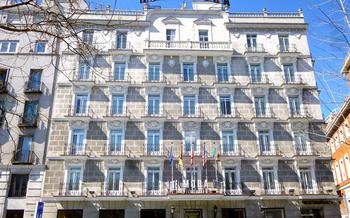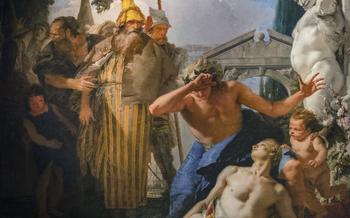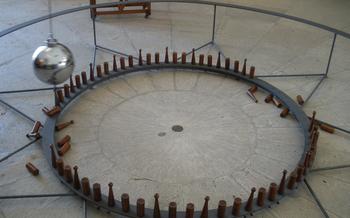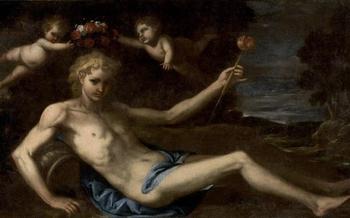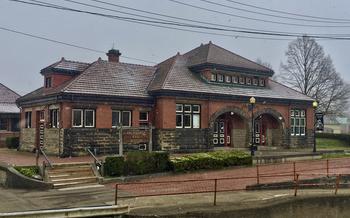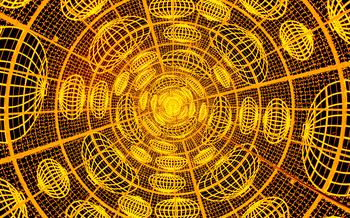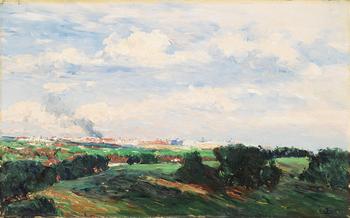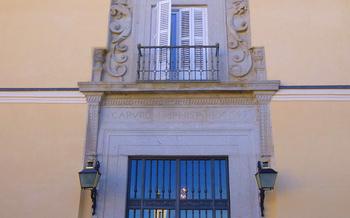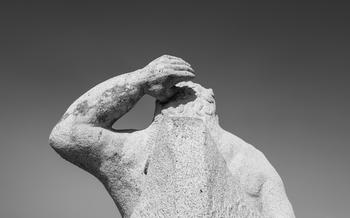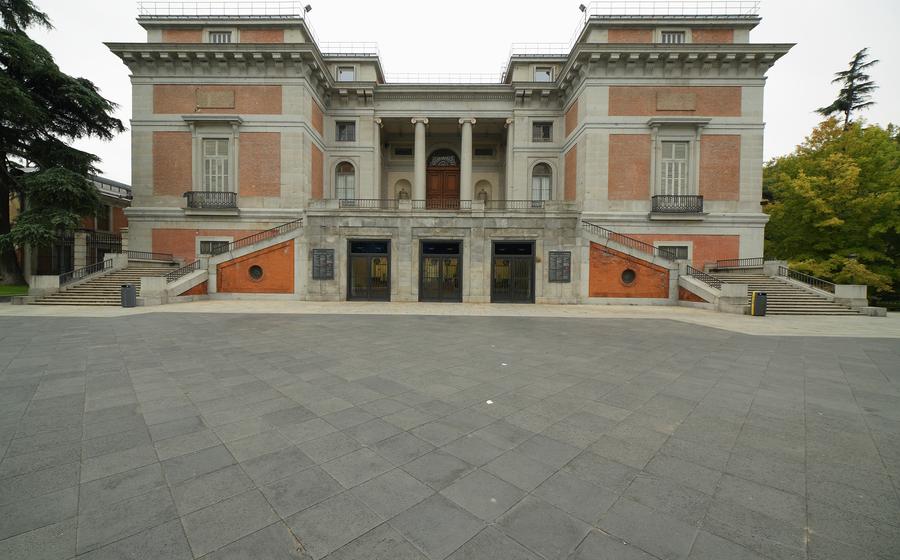
Prado Museum
- Prado Museum: A Masterpiece of Art and History
- Planning Your Visit: Essential Tips
- Navigating the Museum's Layout
- Exploring Spanish Masterpieces
- Unveiling Flemish Masterpieces
- Admire Sculptures and Decorative Arts
- Temporary Exhibitions and Special Events
- Museum Amenities for Visitors
- Tips for a Memorable Experience
- Nearby Attractions and Activities
- Photography and Social Media Sharing
- Educational Programs and Workshops
- Preservation and Conservation Efforts
- Insider Tip: Hidden Gems
Prado Museum: A Masterpiece of Art and History
The Prado Museum stands as a testament to the artistic and cultural richness of Spain. Founded in 1819, it houses one of the world's finest collections of European art, spanning from the 12th to the 20th centuries. The museum's grand neoclassical building, designed by Juan de Villanueva, is a work of art in itself, with its elegant facade and spacious galleries.
The Prado's collection boasts over 8,600 paintings, 700 sculptures, and countless other works of art. Highlights include masterpieces by Spanish masters such as Francisco Goya, El Greco, Diego Velázquez, and Bartolomé Esteban Murillo. Flemish greats like Jan van Eyck, Hieronymus Bosch, Pieter Brueghel the Elder, and Rubens are also well-represented. Visitors can also admire works by Italian masters such as Raphael, Titian, and Tintoretto.
The Prado Museum is not just a repository of art; it is a place where history comes alive. The paintings and sculptures on display tell the story of Spain's rich cultural heritage, its triumphs and tribulations, its people and their way of life. A visit to the Prado is a journey through time, a chance to experience the beauty and power of art that has shaped the world we live in.
Planning Your Visit: Essential Tips
To make your visit to the Prado Museum as smooth and enjoyable as possible, planning is essential. First, consider the best time to visit. While the museum is open every day except for certain holidays, the crowds can be overwhelming, especially during peak tourist season. To avoid the throngs of visitors, aim for weekdays or early mornings. Advance booking of tickets is highly recommended to guarantee entry and skip the often-long lines. The museum's official website offers a user-friendly online ticketing system where you can select your preferred date and time slot. For a more in-depth experience, guided tours are available in various languages, providing insights into the museum's collection and history. Lastly, the Prado Museum is committed to accessibility for visitors with disabilities, offering special facilities like wheelchairs, ramps, and elevators throughout the building.
Navigating the Museum's Layout
The Prado Museum's extensive collection is meticulously organized, making it easy for visitors to navigate and explore. The museum's layout is designed to showcase the diverse artistic movements and periods represented in its collection.
Thematic organization is employed to create a structured and cohesive visit. The museum's galleries are divided into sections dedicated to Spanish art, Flemish art, Italian art, and decorative arts. Each section offers a focused exploration of a particular artistic tradition.
Spanish Art:
- This section houses masterpieces by renowned Spanish artists, including Francisco Goya, El Greco, Diego Velázquez, and Bartolomé Esteban Murillo.
- Goya's works, such as "The Third of May 1808" and "Saturn Devouring His Son," offer a glimpse into the political and social turmoil of his time.
- El Greco's distinctive style, characterized by elongated figures and vibrant colors, is showcased in works like "The Burial of Count Orgaz."
- Velázquez's realistic paintings, including "Las Meninas" and "The Surrender of Breda," provide a window into the court of King Philip IV.
- Murillo's serene and emotive religious paintings, such as "The Immaculate Conception," showcase his mastery of light and color.
Flemish Art:
- This section features works by Flemish masters such as Jan van Eyck, Hieronymus Bosch, Pieter Brueghel the Elder, and Peter Paul Rubens.
- Van Eyck's meticulous attention to detail is evident in works like "The Arnolfini Portrait" and "The Ghent Altarpiece."
- Bosch's fantastical and symbolic imagery, as seen in "The Garden of Earthly Delights," offers a glimpse into the medieval mind.
- Brueghel's scenes of everyday life, such as "The Peasant Wedding" and "The Hunters in the Snow," provide a humorous and insightful look at Flemish society.
- Rubens' dynamic and colorful Baroque masterpieces, including "The Descent from the Cross" and "The Three Graces," exemplify the exuberance of the Flemish Baroque style.
Exploring Spanish Masterpieces
The Prado Museum is a treasure trove of Spanish art, showcasing the works of some of the most renowned masters in history. Among them, Francisco Goya stands out as a revolutionary figure who challenged artistic conventions and left an indelible mark on the Spanish art scene. His works, such as "The Third of May 1808" and "Saturn Devouring His Son," are powerful and evocative, capturing the turmoil and intensity of the times.
El Greco, with his distinctive style characterized by elongated figures and vibrant colors, is another highlight of the collection. His paintings, such as "The Burial of Count Orgaz," are both deeply spiritual and visually striking, inviting viewers to contemplate the mysteries of life and death.
Diego Velázquez, a master of realism, is represented by several key works, including "Las Meninas" and "The Surrender of Breda." These paintings offer a glimpse into the Spanish court and the artist's keen observational skills, capturing both the grandeur and the humanity of his subjects.
Bartolomé Esteban Murillo, known for his serene and emotive religious paintings, is also well-represented in the Prado. His works, such as "The Immaculate Conception" and "The Holy Family with a Bird," exude a sense of tranquility and devotion, inviting viewers to reflect on the divine.
Unveiling Flemish Masterpieces
The Prado Museum boasts an impressive collection of Flemish masterpieces, showcasing the exceptional artistry and unique styles of renowned Flemish painters. Among them, Jan van Eyck stands out with his meticulous attention to detail and groundbreaking techniques. His works, such as the "Arnolfini Portrait", captivate viewers with their realism and symbolism, inviting them to explore the intricate world depicted in each brushstroke.
Hieronymus Bosch's fantastical and symbolic imagery transports visitors to a realm of dreams and nightmares. His triptychs, like the "Garden of Earthly Delights", are a testament to his vivid imagination and ability to blend the mundane with the surreal.
Pieter Brueghel the Elder's scenes of everyday life offer a glimpse into the customs and traditions of 16th-century Flanders. His paintings, such as "The Peasant Wedding", are filled with delightful details and humorous observations, capturing the essence of rural life with wit and charm.
Rubens' dynamic and colorful Baroque masterpieces exude energy and movement. His works, like the "Descent from the Cross", showcase his mastery of composition and use of light, creating a sense of drama and emotion that leaves a lasting impression.
Admire Sculptures and Decorative Arts
Beyond paintings, the Prado Museum boasts an impressive collection of sculptures and decorative arts that complement the narrative of Spanish and European art. Among the sculptural highlights are Greek, Roman, and Renaissance masterpieces, showcasing the evolution of sculptural techniques and styles. Visitors can admire the intricate details of classical marble sculptures, the expressive forms of Renaissance bronzes, and the grandeur of Baroque wood carvings.
The museum's collection of decorative arts is equally captivating, featuring exquisite tapestries, furniture, ceramics, and metalwork. These objects provide a glimpse into the craftsmanship and artistic influences that shaped the era. From intricate tapestries depicting historical scenes to finely crafted furniture adorned with elaborate carvings, the decorative arts offer a unique perspective on the artistic and cultural context of the Prado's collection.
The fusion of paintings, sculptures, and decorative arts creates a comprehensive artistic experience that immerses visitors in the rich history and cultural heritage of Spain and Europe. These diverse art forms contribute to the museum's narrative, offering a deeper understanding of the artistic movements and influences that have shaped the Prado's collection over the centuries.
Temporary Exhibitions and Special Events
The Prado Museum continuously hosts temporary exhibitions that complement its permanent collection, showcasing diverse artistic expressions and perspectives. These exhibitions often focus on specific artists, artistic movements, or historical periods, providing visitors with a deeper understanding of art history.
Special events, workshops, and lectures are organized throughout the year to enhance the museum experience. These events offer unique opportunities for visitors to engage with experts, participate in hands-on activities, and gain insights into the museum's collection.
Limited-time collaborations and partnerships with other institutions bring fresh perspectives and international artworks to the Prado. These collaborations allow visitors to explore connections between different artistic traditions and cultures.
To stay updated on upcoming events and exhibitions, visitors can check the museum's official website, subscribe to its newsletter, or follow its social media channels. The Prado's website also provides detailed information on each exhibition, including dates, ticket prices, and guided tour availability.
By participating in temporary exhibitions and special events, visitors can immerse themselves in the vibrant artistic landscape of the Prado Museum and gain a deeper appreciation for the diversity and richness of its collection.
Museum Amenities for Visitors
The Prado Museum offers a range of amenities to enhance visitors' experiences. Cloakrooms provide a convenient space to store belongings, while restrooms are strategically located throughout the museum. For a quick bite or refreshment, the cafeteria offers a variety of options, including traditional Spanish dishes and light snacks.
The museum is committed to accessibility, ensuring that visitors with disabilities can fully enjoy their visit. Wheelchair ramps and elevators facilitate easy movement throughout the museum, and assistive listening devices are available for guided tours.
The museum shop is a treasure trove of art-related souvenirs, from postcards and posters to replicas of famous artworks. Visitors can also find a selection of books, catalogs, and educational materials to deepen their understanding of the collection.
For those seeking a deeper dive into the world of art, the Prado Museum offers a variety of educational resources. Guided tours led by knowledgeable experts provide in-depth insights into the museum's masterpieces. Workshops and lectures delve into specific artistic techniques, historical periods, and themes. Students, researchers, and art enthusiasts can also access the museum's library and archives, which house a wealth of information on Spanish and European art.
Tips for a Memorable Experience
To fully enjoy your visit to the Prado Museum, ensure a comfortable and immersive experience. Dress comfortably, allowing for ease of movement as you navigate the vast galleries. Consider bringing a notebook or sketchbook to capture artistic inspiration, immortalizing your encounter with the masterpieces. Take breaks in the museum's serene courtyards, offering a tranquil respite amidst the artistic immersion. Finally, savor the surrounding neighborhood's charm, with its beautiful architecture, inviting cafés, and vibrant atmosphere. Let the Prado Museum and its surroundings leave an unforgettable impression, inspiring and enriching your appreciation for art and history.
Nearby Attractions and Activities
After immersing yourself in the Prado Museum's artistic treasures, take some time to explore the vibrant neighborhood of Retiro. Just a short walk away, you'll find the sprawling Retiro Park, a serene oasis in the heart of Madrid. Stroll through its lush gardens, admire the ornate fountains, and row a boat on the tranquil lake for a peaceful retreat.
Art enthusiasts can continue their cultural journey at the nearby Thyssen-Bornemisza Museum, which houses a diverse collection of paintings, sculptures, and decorative arts from the 13th to the 20th century. Don't miss the works of Caravaggio, Rembrandt, Monet, and Van Gogh.
For a taste of Madrid's architectural heritage, take a leisurely walk down the Paseo del Prado, a grand boulevard lined with majestic buildings, including the Cibeles Fountain and the iconic Prado Museum itself. Admire the elegant facades, intricate sculptures, and historical monuments that grace this prestigious avenue.
When hunger strikes, indulge in the culinary delights of the surrounding neighborhood. Choose from a variety of restaurants, cafés, and tapas bars offering traditional Spanish cuisine, international flavors, and delectable pastries. Savor the vibrant atmosphere as you dine al fresco and soak in the charm of Madrid's culinary scene.
Photography and Social Media Sharing
Capturing the beauty of the Prado Museum's collection through photography is a natural desire for many visitors. The museum generally permits non-flash photography for personal, non-commercial use, allowing you to create lasting memories of your visit. However, respecting the museum's copyright regulations is essential. Refrain from using photographs for commercial purposes without obtaining the necessary permissions.
Embrace the opportunity to share your artistic discoveries and insights on social media. Share your favorite masterpieces, intriguing details, or personal reflections on the museum's collection. By doing so, you contribute to promoting art appreciation and encouraging others to explore the Prado's treasures.
Remember that responsible and ethical art appreciation is key. Respect the privacy of other visitors and avoid disturbing their enjoyment of the museum. By following these guidelines, you can contribute to a positive and enriching experience for all.
Educational Programs and Workshops
The Prado Museum offers a range of educational programs and workshops tailored to diverse audiences, from children and families to adults and art enthusiasts. These programs provide an immersive and interactive way to engage with the museum's collection and explore the world of art.
Workshops for children and families encourage creativity and artistic expression through hands-on activities inspired by the museum's masterpieces. Children can participate in drawing, painting, and sculpture workshops, while families can embark on thematic tours and storytelling sessions that bring art to life.
Adults can delve deeper into the history, techniques, and symbolism of the Prado's collection through lectures, seminars, and guided tours led by experienced art historians. These programs offer insights into the lives and works of renowned artists, as well as the cultural and historical context of their creations.
To inquire about and register for these programs, visitors can check the museum's website or contact the education department directly. The Prado's educational offerings provide a unique opportunity to learn from experts, foster creativity, and develop a deeper appreciation for the museum's treasures.
Preservation and Conservation Efforts
The Prado Museum takes great pride in preserving its priceless collection for future generations. A dedicated team of conservators works tirelessly behind the scenes to ensure that the artworks remain in pristine condition. They employ various conservation techniques, including restoration, cleaning, and environmental control, to mitigate the effects of age, light, and humidity. The museum also invests in cutting-edge research and technology to develop innovative preservation methods. Visitors can contribute to these efforts by handling artworks with care, avoiding touching or leaning on them, and adhering to the museum's photography guidelines. By respecting and preserving the collection, we ensure that the Prado's treasures continue to inspire and captivate audiences for centuries to come.
Insider Tip: Hidden Gems
Beyond the renowned masterpieces, the Prado Museum holds a treasure trove of hidden gems waiting to be discovered. Venture off the beaten path and explore lesser-visited galleries and corners to uncover lesser-known works of art that offer unique insights and perspectives. Look for the serene landscapes of Joaquín Sorolla, the expressive portraits of Ignacio Zuloaga, and the whimsical still lifes of Luis Meléndez. Each hidden gem reveals a new facet of the museum's vast collection, adding depth and richness to your visit. Embrace the joy of serendipitous discoveries as you delve into the Prado's lesser-known treasures, creating a truly memorable and personalized experience.
